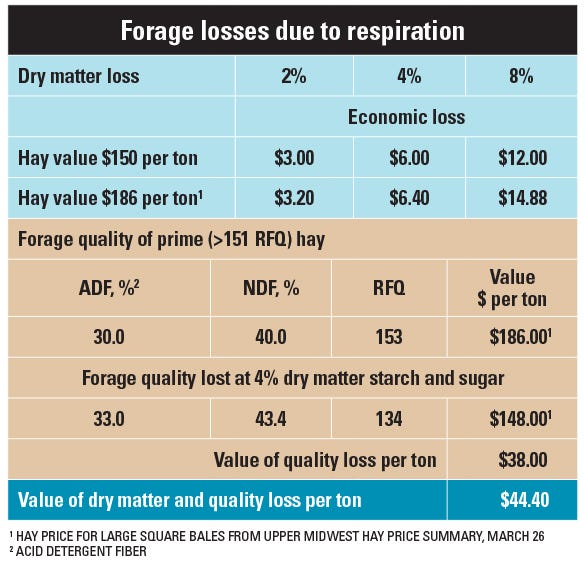
When harvesting hay or haylage, we tend to think in terms of how long it takes to get the hay off the field.
However, the first concern for high-quality hay and haylage should be how long it takes to lose the first 15% to 20% moisture.
Forages have 75% to 80% moisture when cut. They continue to respire sugars (break down and give off heat and carbon dioxide) at a high rate until the plant is dried to 60% moisture. If we want to save the energy of the starch and sugars for our cattle, we need to dry off the first 15% to 20% moisture as quickly as possible.
Most of the respiration takes place in the leaves. We should remember that conditioning is for drying the stems, but it has little impact on drying the leaves.
A wide swath has the biggest effect on the rate of leaf drying. Leaves dry faster in a wide swath because:
• More sunlight falling on the field is intercepted for drying. (A windrow intercepts only 25% to30% of sunlight falling on the field, while a wide swath intercepts 70% to 100% of sunlight.)
• Light keeps the leaf stomates open longer, so moisture can leave through leaf openings. (Most of the forage in a windrow is in the dark, so leaf stomates close to seal the leaf between surface wax layers.)

SOURCE: DAN UNDERSANDER, UNIVERSITY OF WISCONSIN

The accompanying table shows the losses that can occur due to making a windrow rather than a wide swath. Data indicate that starch and sugar loss can range from 2% to 8% of dry matter. If we assume a median starch and sugar loss of 4% of dry matter due to hay in a windrow compared to a wide swath, then the dry matter economic loss is $6.40 per ton, according to current hay prices in the Midwest for large square bales.
However, the respiratory losses of starch and sugar also increase the fiber content of the forage. If the forage was near 40% neutral detergent fiber (NDF) — an indicator of prime hay and haylage — when cut, then the 4% starch loss will increase fiber 3.4 units and lower the quality to Grade 1 hay, or roughly a relative feed quality (RFQ) of 125 to 150.
Wide swath best for forage drying
Grade 1 hay is currently selling for $38 per ton less than prime hay. The value to dairy producers is about twice the price differential between hay grades.
Many farmers have switched to making wide swaths when mowing. A wide swath is the single most important factor affecting forage drying rate. It is more important than conditioning.
Farmers who continue to put hay into windrows are increasing drying time and risk of rain damage. They are also currently losing about $44.40 per ton due to yield and quality losses from increased respiration.
Considering this dollar loss, most farmers could figure out a way to make wider swaths with their existing equipment. They should also look at wide swath mowers when replacing mowing equipment.
Undersander is an Extension forage specialist with the University of Wisconsin. This article first appeared in the May 2018 National Alfalfa and Forage Alliance newsletter and is reprinted with permission.
About the Author(s)
You May Also Like




